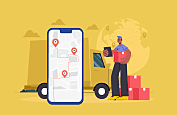
- E-commerce Shipping Statistics: Trends and Insights
- The Impact of the Right E-Commerce Shipping Strategy on Success
- Strategies to Optimize Your Online Store’s Shipping
- How Can Shipping Strategies Impact Customer Satisfaction?
- Exploring the Ecommerce Shipping Carrier Options
- Optimizing Your Online Store’s Shipping Strategies: Discover the Best Companies with MobileAppDaily
- Summing It Up

In the bustling world of e-commerce, having a stellar product isn’t enough anymore. Shipping strategies play a pivotal role in turning casual browsers into loyal customers.
Imagine this: your customer is excitedly awaiting their purchase, and the shipping experience becomes the final touchpoint that seals their impression of your brand. If it’s a hassle, you might lose them forever!
That’s why we need to prioritize the free shipping strategy. Customers expect fast, reliable deliveries with real-time tracking, and even small delays can lead to abandoned carts. In fact, studies show that up to 90% of customers consider shipping quality just as important as product quality. So, how do we ensure our shipping process doesn’t just meet expectations but exceeds them? In this guide, we’ll explore practical strategies to optimize your shipping processes, cut costs, and enhance customer satisfaction, all while keeping your operations running smoothly. Let’s dive in and transform our shipping game!
E-commerce Shipping Statistics: Trends and Insights
- The retail ecommerce landscape is evolving quickly. Worldwide sales are projected to hit an impressive $6.33 trillion in 2024. This represents an 8.76% year-over-year increase. As we navigate these exciting changes, we must consider shipping strategies for ecommerce. These strategies can greatly impact customer experiences.

- Recent data shows that the top three most popular ecommerce sites in the U.S. are Amazon, eBay, and Walmart. This ranking is based on monthly visits as of November 2023. These platforms dominate the market with their extensive offerings. Their success highlights the importance of effective shipping practices.
- Turkey is going to lead the way in online retail sales. 2024 to 2029 will be the growth phase. An 11.6% compound annual growth rate (CAGR) is anticipated. At now, the e-commerce market in Turkey is valued at 3.4 trillion Turkish Lira. Remarkably, both Brazil and India are among the markets with the greatest rates of growth, with CAGRs above 11%. A substantial increase across all areas is indicated by the worldwide retail e-commerce CAGR, which is predicted to be 9.5% for the same time.

- Free delivery is now recognized as a key element affecting customer choice. Four out of ten eCommerce transactions in the US include free delivery. This figure emphasizes how crucial free delivery is to drawing in online customers. In fact, a sizable 49.7% of customers claim that the primary motivator for their online purchases is free shipping. Furthermore, 38% of consumers cite coupons and discounts as motivators.
- A recent survey of over 5,300 shoppers revealed something interesting. An overwhelming 82% of shoppers prefer free shipping over expedited options. This preference shows that shipping costs weigh heavily on shoppers' minds. In fact, many shoppers mentioned they would rather visit a store. They prefer going in-store to avoid paying for shipping altogether. This insight highlights the necessity of effective shipping strategies for ecommerce businesses.
The Impact of the Right E-Commerce Shipping Strategy on Success
Did you know that the average online shopping cart abandonment rate hovers around a staggering 70%? We were just as surprised! While some of this can be chalked up to casual browsing, a significant portion is tied to real concerns. According to the Baymard Institute, nearly 49% of U.S. adults abandon their carts because of high extra costs, including shipping fees.
When shipping costs are steep, you might risk losing potential sales. This makes your ecommerce shipping strategy absolutely vital for boosting customer conversion rates. While shipping speed often depends on the carrier, you have the power to offer competitive prices and flexible options that cater to our customers' needs.
With the right shipping management strategy, you can:
- Enhance the customer journey
- Increase conversions
- Boost our average order value (AOV)
- Expand our business reach
- Decrease overall costs
- Improve operational efficiency
Now that you understand how critical shipping prices are in the conversion process, let’s explore some effective e-commerce marketing strategies to optimize your shipping approach!
Strategies to Optimize Your Online Store’s Shipping
The shipping cost strategy of your online store may be causing you to lose sales. Shipping costs are the main cause of shopping cart abandonment; that is, they are the main reason why a person does not end up buying from an online store.
It is very common for a new customer to enter your website, find a product at a price that suits them, and add it to their cart. However, before completing the purchase, they are unpleasantly surprised to find that shipping costs and management costs have increased the price of their purchase and will most likely affect their purchase decision. This highlights the importance of mobile readiness, as more shoppers are using their smartphones to browse and buy. Let's look at some of the shipping cost strategies that you can choose to increase sales in your e-commerce.
1. Free Shipping
Free shipping is the type that generates the best customer recall and, at the same time, reduces the volume of abandoned shopping carts in the online store. However, it has a cost that you must absorb, and it is possible that in the initial phases of e-commerce, it will consume a large part of your margin.
On the other hand, the feeling of waiting associated with online shopping is reduced thanks to the satisfaction of getting free products or services. This means that the customer tolerates a long shipping time better if it is free.
If you want to encourage purchases but do not consider the option of lowering your prices, reducing shipping costs to a minimum can be a very interesting option. This type of strategy makes sense when you do not want to devalue the brand by offering discounts, but you need to give a boost to customers.
It is a way to attract attention and close sales without putting up any barriers. This option is valid for stores that have products that are not heavy, not bulky, and have a substantial profit margin.
You must remember to check in which area this type of shipping strategy is offered and limit it to national environments, as it can increase costs if you serve several countries. You do not have to assume the full cost of shipping costs for your business. You can add them to the price of the products either partially or even totally. You could also hire a fulfillment service like AMS to handle the entire pre-shipment process so you do not have to spend time packing, calculating sizes, or choosing boxes.
2. Fixed Price
The third option is to set a fixed price for any purchase. Regardless of the volume, weight, or number of items, the customer will pay a single amount for shipping, with no possibility of avoiding this cost.
This is a widespread but unattractive strategy for generating sales since there is no incentive for consumers to include an extra product in the cart. Therefore, it does not help to increase the average purchase order.
However, if you have a very competitive pricing policy and the shipping cost is low, the feeling of dissatisfaction with paying for shipping can be offset. For example, it is a good option if the shipping costs are 3 euros. Doesn't that sound bad? Almost anyone would be willing to pay 3 euros for shipping costs.
Depending on the price you decide to set, there is a possibility that it will cost you more than what you charge for it, but you can consider it a marketing strategy to try to close the sale. Furthermore, as said in option 1, you can assume the difference with what the shipping costs us directly or also charge it to the price of the products.
3. Shipping Costs by Amount
The shipping cost strategy by amount, also known as tiered flat rates, consists of setting a different shipping cost depending on the purchase amount. For example, if you buy less than €50, the shipping cost is €3.5, and if you buy more than €50, it will be free.
As in the previous shipping strategies examples, you have only indicated two “price steps” you could increase to as many as you consider necessary. It should be used carefully so as not to overwhelm the customer and overcomplicate the purchase process.
It is one of the most used shipping strategies for low-volume products since it allows the average order to increase if you use it appropriately. Generally, a free shipping cost is set just above the average order of ecommerce, encouraging the inclusion of more products to achieve free shipping and thus increasing the average order.
4. Expedited Shipping Pricing
Some customers want their products delivered to their doorstep as quickly as possible, but others would rather wait a little longer if it means savings for them. So why not serve them all?
If you have a high expedited shipping cost, typically within 24-48 hours of ordering, and a cheaper standard shipping cost, you can pass these costs on to the consumer. Set a different price based on delivery time and let the customer decide if they are willing to pay for that urgency.
In addition to small businesses where fast shipping costs can be expensive, this strategy is very useful if you can serve the customer from your own warehouse or from a supplier's. Normally, you can ship more quickly from your warehouse, but this will mean additional storage costs, so passing this cost on to the customer can be a financial relief.
5. Pickup in Store
As its name suggests, pick up in store consists of the customer going to a physical location to pick up the order. The customer saves time waiting and can view the catalog from the comfort of their home, and you save on shipping costs.
Although many e-commerce sites do not have this option, if you have a physical sales space, you should take advantage of it. Having a pick up in store shipping option makes your logistics easier and gives you the opportunity to meet the customer in person. You can interact with them and even hand out coupons or loyalty cards in the package.
Once you have all the shipping aspects sorted out, you can be confident that your customers will have a great experience with your online store. Make an effort to offer quality shipping!
6. Dynamic Shipping Rates
Dynamic shipping rates represent a cutting-edge approach to pricing that considers various factors, including UoM volume, destination, shipping method, and carrier. Dynamic shipping rates offer a significant advantage. They adjust shipping costs based on specific order characteristics. For instance, heavier items often lead to higher shipping expenses. Deliveries to distant locations usually incur more costs as well. In contrast, lighter packages typically enjoy lower shipping fees. Local shipments benefit from reduced rates due to their proximity.
Implementing dynamic shipping rates allows your business to find the right balance between attracting customers with reasonable shipping fees and maintaining profitability. This flexibility enables businesses to offer promotions or discounts on shipping when feasible, enhancing the value proposition further. As a result, this strategy is essential for e-commerce development companies aiming to optimize shipping best practices.
7. Limited-Time Shipping Offers
Creating urgency through limited-time shipping offers can effectively motivate customers to finalize their purchases. For instance, providing free shipping during holidays or special promotions can persuade customers to act before the offer expires.
Additionally, pairing shipping deals with other offers—like product bundles or discounts—can make them even more appealing. Automating these offers and cost calculations using specialized shipping rules solutions streamlines the process, ensuring that your free shipping marketing strategy is both efficient and effective.
8. Subscription Shipping Programs
Subscription box shipping is a prevalent strategy for businesses offering subscription-based services or products. Under this model, you regularly ship products to subscribers on a set schedule while customers pay a flat fee for unlimited shipping over a specified period.
This shipping strategy benefits both parties by providing convenience and cost savings. It encourages repeat purchases and fosters long-term customer relationships, ultimately increasing customer lifetime value (LTV).
9. Cash on Delivery
Cash on Delivery (COD) is an ecommerce shipping strategy that allows customers to pay for their orders upon delivery instead of in advance. This method provides the convenience of inspecting the product before making payment, reducing the risk of fraudulent transactions and enhancing customer trust.
Enabling COD shipping can broaden your customer base, attracting those who prefer not to pay upfront or have limited access to electronic payment methods. This strategy can also boost sales conversion rates by minimizing purchase hesitancy. However, it’s important to note that the COD strategy may not be supported by all carriers, potentially limiting your choices.
By employing these shipping strategies for eCommerce, businesses can enhance their operational efficiency while improving customer satisfaction.
ALSO READ: A Complete Guide on How to Start an E-Commerce Business
How Can Shipping Strategies Impact Customer Satisfaction?
Now that we’ve explored various shipping optimization strategies let’s dive into how these approaches can significantly enhance customer satisfaction.
1. Speedy Deliveries That Wow Customers
Waiting for a late package is always frustrating. In today’s fast-paced world, customers want quicker deliveries. They now expect their orders to arrive faster than ever before. Thanks to major shipping companies, you can be used to receiving packages within days of clicking “buy.” This high speed has set a new standard for customer expectations.
By choosing the right carriers, you can reduce delivery times significantly. A smart logistics shipping pricing strategy helps exceed those expectations with ease. Imagine the joy when your customers receive their packages ahead of time. It's a simple way to build trust and loyalty.
2. Real-Time Tracking for Peace of Mind
Ever wondered why real-time order tracking has become a must-have for online shoppers? It’s all about peace of mind! Customers love being able to check the status of their orders and get accurate delivery estimates. Some services even let them see where their packages are on a global map. This level of transparency not only reduces anxiety about missing packages but also enhances the overall shopping experience.
For those looking to explore profitable e-commerce business ideas, incorporating such features can set your store apart. It’s a small touch that can make a big difference!
3. Cost-Effective Shipping for Competitive Edge
Who doesn’t love a good deal? With efficient shipping strategies in place, you can offer competitive pricing that attracts more customers. By minimizing shipping costs through careful carrier selection and smart packaging, you can pass those savings directly to your customers. This might even allow you to roll out occasional free shipping strategies—and let’s be honest, who doesn’t love free shipping?
4. Fewer Errors, Happier Customers
Shipping errors, delays, and other issues can lead to frustration and negative reviews—something every business wants to avoid. Nowadays, customers have little patience for mistakes. By implementing effective shipping process optimization, you can significantly reduce errors and ensure a smoother shipping experience. After all, happy customers are repeat customers, and that’s what every business strives for!
Incorporating these elements into your shipping and fulfillment strategy not only streamlines operations but also aligns perfectly with your overall eCommerce marketing strategies. When your customers feel valued and satisfied, they’re likely to return—and isn’t that the goal?
Exploring the Ecommerce Shipping Carrier Options
When it comes to ecommerce shipping strategies, there are a variety of carriers at our disposal, each with its unique approach to calculating rates and negotiating discounts. Finding the right carrier becomes even more crucial when you’re shipping internationally or to remote areas, so let’s take a closer look at some of the best options.
1. UPS
United Parcel Service (UPS) is a heavyweight in the shipping game, serving over 200 countries and territories while delivering an astounding 24 million packages daily. You should appreciate UPS for its commitment to time-definite deliveries, offering options like UPS Ground for domestic deliveries in 1-5 business days, UPS Next Day Air for one-day domestic shipping, and UPS 2nd Day Air for two-day domestic service.
Plus, the UPS shipping portal and APIs integrate seamlessly with the ecommerce platforms, making order processing a breeze.
2. USPS
When it comes to shipping best practices, you can’t overlook the United States Postal Service (USPS), which is known for its low rates on smaller packages. USPS provides domestic shipping throughout the U.S. and offers Priority Mail international shipping (6-10 business days) to over 180 countries. Depending on your location, we might even qualify for free package pickup right from your home or office.
The flat rate boxes are a game-changer, allowing you to ship items of various weights at a fixed cost, simplifying your shipping cost calculations. Additionally, USPS provides parcel return services, making it easy for your customers to send items back.
3. FedEx
For those time-sensitive deliveries or valuable items, you can often turn to FedEx. It offers a variety of shipping options, including FedEx Express Saver for three-day delivery, FedEx 2-day shipping, and FedEx Standard Overnight. Plus, you can rely on FedEx for dependable cross-border shipping and customs clearance in over 220 countries and territories.
Let’s not forget their packaging solutions are designed to protect fragile or high-value items during transit—a must-have for your shipping management strategy.
4. DHL
When it comes to international shipments, DHL stands out as one of the most trusted carriers. DHL provides various time-sensitive delivery services, making international shipping fast and reliable. Options like express deliveries and freight forwarding cater to both urgent and standard needs. For instance, DHL Express Worldwide ensures your package arrives on a guaranteed day. If you're in a hurry, DHL Express 9:00 delivers by 9 a.m. on a specified date.
You will love that DHL offers carbon-neutral shipping for U.S.-based deliveries. This aligns perfectly with our goal of sustainability. By choosing DHL, you can reduce your carbon footprint while ensuring fast, reliable shipping. It’s a win for the planet and for your customers.
Choosing the right shipping carrier plays a crucial role in our shipping marketing strategy. It’s important to explore all available options to make informed decisions. By doing this, you can develop shipping strategies tailored to ecommerce needs. These strategies allow for streamlining shipping management and improving overall efficiency, especially when integrated with the best ecommerce platforms that support these efforts.
Optimizing Your Online Store’s Shipping Strategies: Discover the Best Companies with MobileAppDaily
At MobileAppDaily, we understand that optimizing your online store’s shipping strategies for success is crucial for your business. That’s why we offer several directories designed to help you find the best companies in the industry. Whether you’re looking for top-tier logistics providers or cutting-edge tech solutions, our directories have got you covered.
One of our standout resources is the directory for e-commerce app development companies. Here, you’ll find experts who build strong platforms tailored to your shipping and fulfillment needs. With the right app development partner, you can easily streamline and optimize the shipping process. They’ll help ensure that your customers have a smooth experience from the moment they buy to the time they receive their orders.
Additionally, as you consider implementing an international shipping strategy, our directory can connect you with the right companies that have a proven track record in global logistics. This ensures that your products reach customers across borders efficiently and effectively.
Explore our directories today, and let us help you take your online store to the next level!
Summing It Up
In conclusion, optimizing your online store's shipping strategies is vital for achieving success in today’s competitive e-commerce landscape. By implementing effective shipping strategies, you can enhance customer satisfaction, reduce cart abandonment rates, and boost our bottom line. It’s essential to evaluate various shipping strategies, from offering competitive rates to providing transparent tracking information, to meet your customers’ expectations.
Integrating a strong ecommerce shipping strategy is key to attracting more shoppers. Highlighting benefits like free shipping or expedited delivery can draw in customers. These perks make your store stand out as a convenient and reliable option. Shoppers love convenience and value, and you can offer both through these strategies. By focusing on shipping benefits, you will build trust and loyalty with your customers.
Let’s embrace these tactics to create a smooth and enjoyable shopping experience. When customers know they can count on fast, reliable delivery, they’re more likely to return. A well-executed shipping plan can boost customer satisfaction and increase repeat business.
Frequently Asked Questions
-
What are the most effective shipping strategies for eCommerce businesses?
-
What role does free shipping play in a successful shipping strategy?
-
What technology can optimize shipping strategies?
-
How can sustainable shipping be integrated into strategies?

Content Writer
Sakshi Kaushik is a wordsmith extraordinaire who transforms complex technical jargon into captivating, must-read articles. Armed with a Masters in Economics, Sakshi dissects intricate topics with the precision of a seasoned expert. Her insights have graced prestigious platforms like Hackernoon, Ecowiser, and Medium, captivating readers and tech aficionados alike. With a career spanning influential companies like Teleperformance, Finex, and SparxIT Solutions, Sakshi is well-versed in navigating both the keyboard and the boardroom.
In addition to her extensive experience, Sakshi holds HubSpot certifications in Digital Advertising and Content Marketing, and has earned further credentials from UpGrad, Coursera, and Great Learning. Dedicated to sharing her expertise with mobile app developers and tech enthusiasts, Sakshi's passion shines through her writing. When she's not crafting compelling content, she enjoys diving into thrilling novels and exploring diverse worlds.














